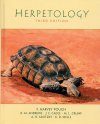Textbook
Out of Print
By: F Harvey Pough(Author), RM Andrews(Author), JE Cadle(Author), ML Crump(Author), Alan H Savitzky(Author), KD Wells(Author)
726 pages, 200 b/w photos, line illus, figs, tabs
![Herpetology Herpetology]()
Click to have a closer look
About this book
Contents
Related titles
About this book
Comprehensive and authoritative advanced and undergraduate textbook for students of zoology, ecology, behaviour, conservation and evolutionary biology. It covers ecology, behaviour, physiology, morphology and evolution of amphibians and reptiles.
Contents
I. WHAT ARE AMPHIBIANS AND REPTILES?
1. Herpetology as a Field of Study
- The Diversity of Amphibians and Reptiles
- Shared Characters of Amphibians and Reptiles
- Amphibians and Reptiles in Terrestrial Ecosystems
- Development of Herpetology as a Field of Study
- The Future of Amphibians and Reptiles
- Summary
2. The Place of Amphibians and Reptiles in Vertebrate Evolution
- Phylogenetic Systematics
- The Transition from fishes to Tetrapods
- The Ecological Transition in Tetrapod Origins
- Monophyly of Lissamphibia
- Two Hypotheses for Relations between Lissamphibians and Paleozoic Amphibians
- Paedomorphosis in Lissamphibian Evolution
- Relationships among Extant Orders of Lissamphibia
- The Radiation of Amniotes
- Summary
3. Systematics and Diversity of Extant Amphibians
- Salamanders (Urodela or Caudata)
- Systematics and Phylogeny of Salamanders
- Caecilians (Gymnophiona)
- Systematics and Phylogeny of Caecilians
- Frogs (Anura)
- Systematics and Phylogeny of Frogs
- Summary
4. Systematics and Diversity of Extant Reptiles
- Turtles (Testudines or Chelonia)
- Systematics and Phylogeny of Turtles
- Lepidosauria
- Tuatara (Rhynchocephalia)
- Lizards and Snakes (Squamata)
- Systematics and Phylogeny of Lizards
- Snakes (Serpentes)
- Systematics and Phylogeny of Snakes
- Archosauria: Crocodilians (Crocodylia)
- Systematics and Phylogeny of Crocodilians
- Summary
5. The Biogeography of Amphibians and Reptiles
- The Nature and Scope of Biogeography
- Biogeographic Processes and Analysis
- The Geophysical Context for Historical Biogeography
- Continental Fragmentation and the Biogeography of Amphibians and Reptiles
- Some Island Patterns
- Merging Faunas: North and South America, the Great American Interchange, and the West Indies
- Generating Diversity: Salamanders and Frogs on Tropical Mountains
- Regional Phylogeography
- Summary
II. HOW DO THEY WORK?
6. Temperature and Water Relations
- Pathways of Energy and Water Exchange
- Water Uptake and Loss
- Water in the Lives of Amphibians and Reptiles
- Heat Gain and Loss
- Behavioral Aspects of Thermoregulation
- Cardiovascular Control of Heating and Cooling
- The Thermal Ecology of Amphibians and Reptiles
- Freezing Resistance and Freezing Tolerance
- Evolution of Thermal and Evaporative Characteristics
- Summary
7. Energetics and Performance
- Sites of Gas Exchange
- Patterns of Blood Flow
- Functions of Intracardiac Shunts
- ATP Synthesis: Oxidative and Glycolytic Metabolism
- Energy Costs of Natural Activities
- Annual Energy Budgets
- Environmental Variables and Performance
- Performance and Fitness
- Trade-Offs
- Summary
8. Reproduction and Life Histories of Amphibians
- Sex Determination
- Reproductive Cycles
- Modes of Fertilization
- Hybridogenesis and Gynogenetic Reproduction
- Reproductive Modes
- Evolution of Direct Development and Live-Bearing
- Evolution of Parental Care
- Egg Size and Clutch Size
- Larval Development, Complex Life Cycles, and Metamorphosis
- Paedomorphosis
- Summary
9. Reproduction and Life Histories of Reptiles
- Sexual and Asexual Reproduction
- Sex Determination
- Reproductive Cycles
- Reproductive Modes, Gametes, and Fertilization
- Eggs, Embryonic Development, and the Physiological Ecology of Eggs and Embryos
- Parental Care
- Viviparity
- Life-History Variation
- Summary
10. Body Support and Locomotion
- Body Support, Thrust, and Gait
- Lever Systems
- Terrestrial Locomotion with Limbs
- Jumping
- Terrestrial Limbless Locomotion
- Aquatic Locomotion
- Burrowing
- Climbing
- Aerial Locomotion
- Summary
11. Feeding
- Suction and Suspension Feeding
- Terrestrial Feeding Mechanisms
- Cranial Kinesis
- Envenomation
- Pit Organ
- Herbivory
- Summary
III. WHAT DO THEY DO?
12. Movements and Orientation
- Ecological Consequences of Movement
- Methods for Studying Movements
- Types of Movement
- Local Movements and home Range
- Territoriality
- Migration
- Movement of Juveniles
- Homing Behavior
- Mechanisms of Orientation
- Summary
13. Communication
- Modes of Communication
- Constraints on Signal production
- Communication and Noise
- Communication by Salamanders
- Communication by Anurans
- Communication by Turtles
- Communication by Crocodilians
- Communication by Lepidosaurs
- Summary
14. Mating Systems and Sexual Selection
- The Relationship of Mating Systems and Sexual Selection
- Mating Systems of Amphibians and Reptiles
- Variables Affecting Male Reproductive Success
- Patterns of Sexual Size Dimorphism
- Summary
15. Diets, Foraging, and Interactions with Parasites and Predators
- Diets
- Amphibians and Reptiles as Predators
- Interactions with Parasites
- Interactions with Predators
- Coevolution of Predators and Prey
- Summary
16. Species Assemblages
- Gradients in Species Richness
- Determinants of Assemblage Structure and Composition
- Case Studies of Amphibian and Reptiles Assemblages
- Summary
IV. WHAT ARE THEIR PROSPECTS FOR SURVIVAL?
17. Conservation and the Future of Amphibians and Reptiles
- Conservation Biology
- Major Themes
- Human Perceptions of Amphibians and Reptiles
- Impact of Humans on Amphibians and Reptiles
- Patterns of Species Extinction and Extirpation
- Conservation Options
- Declining Amphibians: A Model Issue
- Summary
- Bibliography
- Illustration Credits
- Author Index
- Subject Index
Customer Reviews
Textbook
Out of Print
By: F Harvey Pough(Author), RM Andrews(Author), JE Cadle(Author), ML Crump(Author), Alan H Savitzky(Author), KD Wells(Author)
726 pages, 200 b/w photos, line illus, figs, tabs


















![Belize Field Guide: Mammals, Amphibians and Reptiles [English / Spanish]](http://mediacdn.nhbs.com/jackets/jackets_resizer_medium/18/181132.jpg?height=150&width=63)









